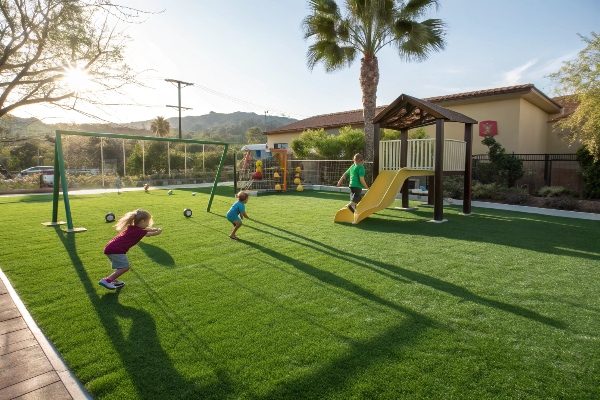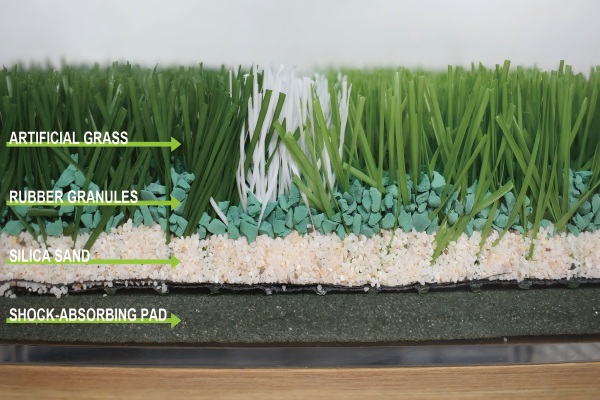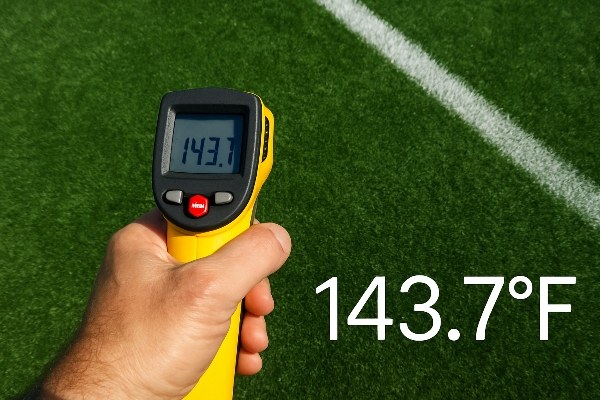Tired of muddy, unsafe playgrounds that need constant work? This downtime means unhappy kids and endless costs. Artificial grass offers a clean, reliable, and durable solution for year-round play.
Yes, artificial grass is an excellent choice for playgrounds. It provides superior safety with shock-absorbent padding, exceptional durability for heavy use, and very low maintenance. This ensures a clean, consistent, and always-ready play area compared to traditional surfaces like sand, wood chips, or natural grass.

Choosing the right surface for a playground is a big decision. As an engineer in this industry for years, I’ve seen firsthand what works and what doesn’t. You need to balance safety, cost, durability, and how the space will actually be used. Natural grass looks nice, but it turns to mud in the rain and dirt in the sun. Sand and woodchips get everywhere and can hide sharp objects. Artificial grass solves many of these problems, but it’s not a simple "one-size-fits-all" product. Let’s break down the real pros and cons to help you make the best choice for your project. I want to give you the practical knowledge you need to invest wisely.
Why Choose Artificial Grass for a Playground?
A child’s safety is your number one concern, and falls are bound to happen. Hard or uneven surfaces can turn a small trip into a serious injury. A proper artificial grass system provides a cushioned, tested, and reliable surface that helps protect children when they fall.
You should choose artificial grass because it is designed for safety and can include shock-absorbent padding. It is also extremely durable for high-traffic areas, requires very little maintenance, and stays clean without mud. This means it is usable all year, providing better long-term value.

When I consult with clients on playground projects, I always start the conversation with safety. It’s the foundation of a good playground. But the benefits go far beyond just safety. It’s about creating a better, more reliable play environment. Let’s dive deeper into the specific advantages.
The Complete Safety System
The most important thing to understand is that playground turf is a "system," not just a carpet. The grass itself provides the durable surface, but the safety comes from what’s underneath. This system typically includes:
- A properly prepared base: For drainage and stability.
- A shock pad: This is the critical safety layer. It’s a foam-like pad installed under the turf that absorbs impact.
- The artificial turf: The visible green layer.
- Infill: Granules brushed into the turf fibers to help them stand up and add cushioning.
This entire system is tested for its Critical Fall Height (CFH) rating. This rating, determined by standards like ASTM F1292 in the US, tells you the maximum height from which a child could fall without sustaining a life-threatening head injury. For example, a system with a 6-foot CFH rating is safe for play equipment up to 6 feet high. I once worked with a school that wanted to save money by using a thinner shock pad. I showed them the test data and explained that a thinner pad would not meet the safety requirements for their new climbing frame. We found a different way to adjust the project budget without compromising on the children’s safety.
Incredible Durability and Low Maintenance
Playgrounds see a lot of action. Children run, jump, and slide, which quickly wears down natural grass, creating bare, hard patches. Artificial grass is built for this. The fibers, or yarns, are made from tough materials like polyethylene and are shaped to be resilient (I often recommend C-shaped or S-shaped yarns because they spring back up well after being stepped on). The density of the turf, determined by its stitch rate and gauge, also plays a huge role in its lifespan. A denser turf will last much longer in a high-traffic area.
Compared to natural grass, the long-term maintenance is minimal. This is where you see a real return on your investment.
| Maintenance Task | Natural Grass (Annual Cost) | Artificial Grass (Annual Cost) |
|---|---|---|
| Mowing/Labor | High | None |
| Watering | High | None (or minimal for cleaning) |
| Fertilizing | Moderate | None |
| Weed/Pest Control | Moderate | None |
| Reseeding/Repairs | Moderate | Low (repairs are rare) |
| Total | High & Ongoing | Very Low |
All-Weather Use and Cleanliness
One of the biggest advantages is that the fun doesn’t have to stop when it rains. Artificial turf has a perforated backing that allows water to drain right through into the prepared base underneath. This means no puddles and, most importantly, no mud. Kids can play almost immediately after a storm without getting dirty. This keeps them cleaner, keeps parents happier, and prevents mud from being tracked indoors. It also means your playground is available for use far more days out of the year, maximizing its value.
What Are the Drawbacks of an Artificial Grass Playground?
Artificial grass seems perfect, but what is the catch? The high initial cost can be a surprise, and worries about heat on sunny days might make you hesitate. Understanding these drawbacks honestly is the key to making a smart, informed decision that you won’t regret later.
The main drawbacks are a higher initial installation cost compared to seeding a lawn and its tendency to get hot in direct, intense sunlight. There are also valid environmental questions about the materials used and how the turf is recycled at the end of its life.

I believe in being completely transparent with my customers. If a product has weaknesses, you need to know about them and you need to know how to manage them. Ignoring these issues is a mistake. A good supplier will not only tell you about the potential problems but will also offer you effective solutions. Let’s look at these challenges one by one and discuss the practical ways to overcome them.
The Upfront Investment
There’s no doubt about it: the initial cost to install an artificial grass playground is higher than planting natural grass. You are paying for a complex, manufactured system. The cost includes the turf itself, the crucial shock pad, infill material, and the extensive groundwork and labor needed for a proper installation. Many people get "sticker shock" when they see the initial quote.
However, I always advise my clients to look at the Total Cost of Ownership over a 10-15 year period. The high upfront cost is balanced by extremely low annual maintenance costs. Natural grass is cheap to start, but the ongoing costs of water, fertilizer, mowing, and labor add up year after year.
Here’s a simple cost projection for a hypothetical 500 square meter playground over 10 years:
| Cost Item | Artificial Grass System | Natural Grass |
|---|---|---|
| Initial Install | $25,000 – $40,000 | $3,000 – $7,000 |
| Annual Maint. | ~$200 (cleaning) | ~$2,000 (water, labor, etc.) |
| 10-Year Maint. | ~$2,000 | ~$20,000 |
| Total 10-Year Cost | $27,000 – $42,000 | $23,000 – $27,000 |
Note: These are estimates. The numbers show that while artificial grass starts higher, the long-term costs become very competitive, especially when you factor in the added benefits of durability and usability.
Managing Surface Temperature
Yes, artificial grass can get hot in direct, strong sunlight. The plastic fibers and rubber infill absorb heat more than natural grass, which has a natural cooling effect. This is a serious consideration, especially in hot climates. In my work with customers from places like Mexico and the Middle East, this is often the first drawback we discuss.
Fortunately, we have effective solutions:
- Choose a "Cool" Infill: Black crumb rubber is the hottest option. Lighter-colored sand is better. Modern premium options like TPE (Thermoplastic Elastomer) or organic infills (like cork) stay much, much cooler.
- Select Heat-Reflective Turf: Some turf products are made with special yarns that have heat-reflective properties. They are designed to stay cooler than standard fibers.
- Use Water to Cool: A quick spray from a hose or a simple irrigation system can cool the surface dramatically. The water evaporates, just like sweat, and cools the turf down for hours.
- Install Shade: The most effective solution is often the simplest. Planting trees or installing shade sails over the play area not only cools the turf but also protects children from UV rays.
Environmental Considerations
The environmental impact of artificial turf is a valid and growing concern. The two main issues are the use of plastics and what happens at the end of the turf’s 15-20 year lifespan. Being honest about this is important. Traditional turf is difficult to recycle because it is made of different materials (backing, fibers, infill) bonded together.
The industry is working hard on this. As an engineer, I am excited about the new products I am seeing. We are developing turf systems made from a single type of polymer, which makes them 100% recyclable. We are also seeing more non-infill systems for playgrounds which eliminates any concern about infill migration. Choosing a supplier who is transparent about their materials and is investing in sustainable solutions is a good way to address these concerns responsibly.
Conclusion
Artificial grass is a fantastic choice for playgrounds, offering top-tier safety, durability, and low maintenance. Weigh the higher initial cost and heat concerns against these long-term benefits to make your decision.
_画板-1.png)
_画板-1.png)